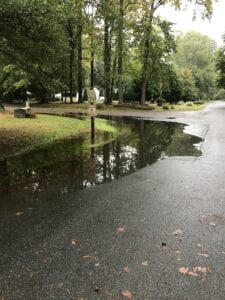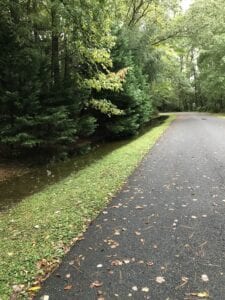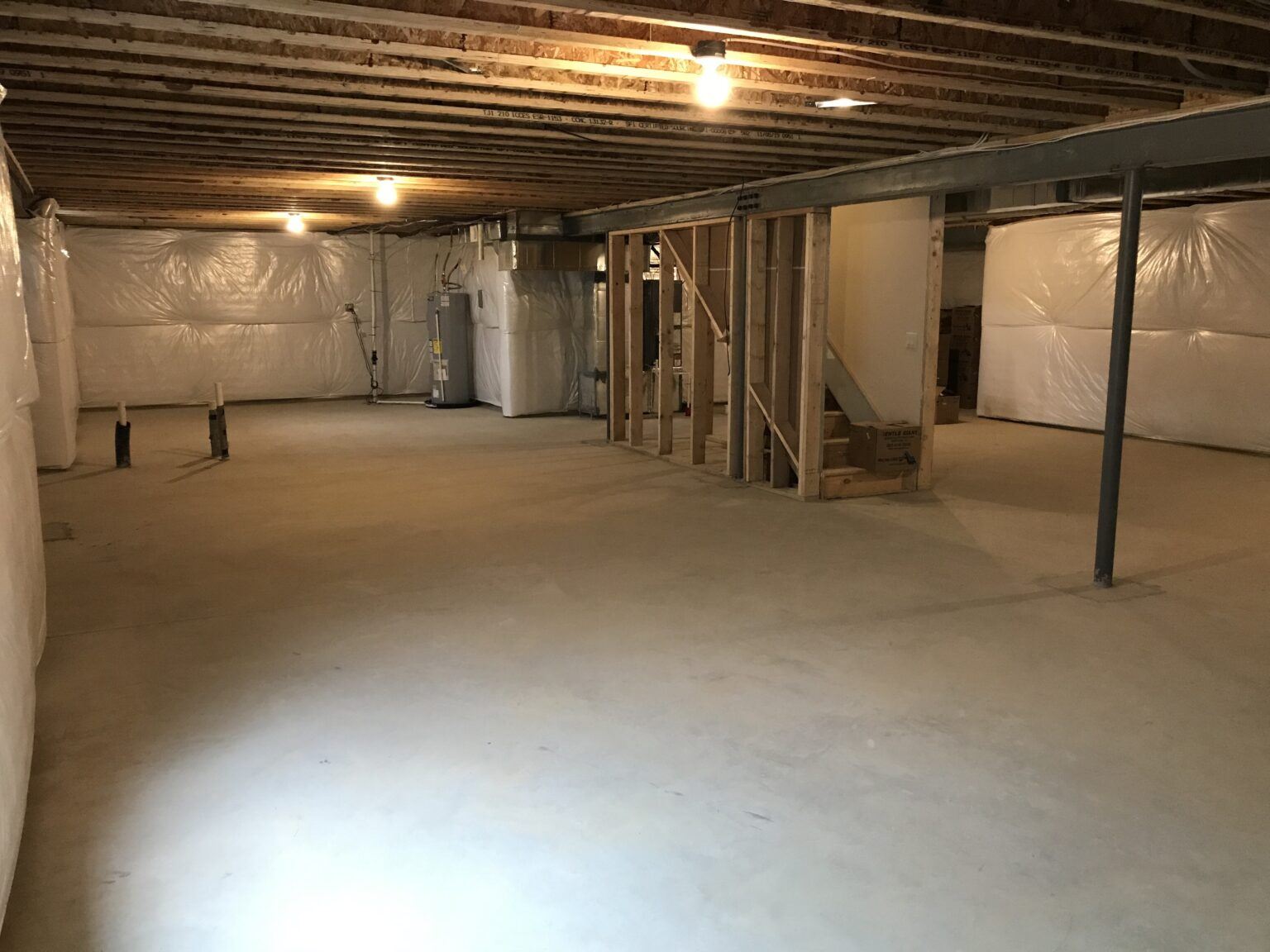Drainage is an essential component of a house. It prevents flooding, which can cause significant damage to your property. You can avoid flooding with different solutions for your yard, and a drainage swale is one of them.
In the US, swales are shallow channels often covered with grass to look like a continuation of the house lawn. Their primary purpose is to collect and manage water flow by slowing the current and redirecting it to the desired destination.
I had never heard of a drainage swale until we purchased our new house in Lewes. I was curious about this topic because drainage swales have proven to be useless in our neighborhood. If they are supposed to help with drainage why does our neighborhood look like the pictures below the minute it rains.
Let’s go over the main features, as well as advantages and disadvantages of drainage swales.
What Exactly Is a Drainage Swale?
In general terms, a swale is a depression in the ground engineered to carry rainwater through gravity to the desired destination.
Drainage swales are one of several types of surface drainage systems that slowly filter runoff water as it sinks into the soil while redirected to another location.
Swales are typically covered with either grass or another type of vegetation. That makes them easy to blend into the environment and landscaping. It is important that vegetation is not very thick and large because it could obstruct the water flow.
People often confuse drainage swales with trench drains. Both are surface drainage systems but are different. Think of trench drains as gutters (pipes) for the ground. There are no pipes involved with swales.
Drainage swales’ primary purpose is to slow down and control the water flow and prevent flooding or puddle formation. It is also an excellent erosion prevention method.
Swales are very useful during heavy rainfall because of their ability to slow down the flow. This actually helps the storm drain systems and saves them from overflooding.
This system can be used in both residential and business/industrial zones.
Due to depth and size, it has a moderate ability to control heavy flow and reduce its volume. Filtration and sedimentation are quite good for removing pollutants and particles.
The grass is there to act as a surface filter, while roots will use the nutrients provided by water. Grass or other vegetation is also excellent for holding larger contaminants.
Drainage Swale Construction
Because drainage swales are shallow, they do not require any special construction materials, making them easy to build. If you want to have one on your property, you will have to find a suitable location.
The swale has to collect water and redirect it towards some other drainage system, like a storm drain.
To build it, you will have to dig it up and ideally cover it with grass or other vegetation. Vegetation is great as a cover because the roots hold the soil in place, and the water will not wash it away.
The swale sides should have a very gentle slope and should be about four times wider than they are tall. If they are built on flat ground where there is no natural pitch, you will have to create a slope to enable drainage and flow.
The logical way to do this is to dig the middle part deeper and deeper as you build it towards the swale end where you want to direct the water.
A nice plus of swales is that they blend well with the rest of the yard, and you can easily incorporate it almost anywhere. Some people even use it in their lush gardens to direct water towards certain plants.
Property owners frequently have them constructed next to their parking spots and sloping driveways.
This May not be the Easiest DIY Project
Although they are easy to construct conceptually, drainage swales are not easy to implement, as evidenced by the builders’ poor job in our neighborhood.
It is not as simple as starting to dig at the end of your front yard, and hope it works. If the house was not built with a comprehensive drainage system in mind, rainwater might go anywhere.
Building codes and inspections should ensure the house is adequately built to carry rainwater away from your property. And yet, I have seen many houses in Delaware surrounded by water after heavy rain.
Residential areas have drainage systems, and if you decide to add more, it must not interfere with it. Additionally, you may cause flooding at the house next door when you redirect water from your property.
Depending on your local residential code or even your Homeowners Association, you may not be allowed to construct it where or how you want.
Before you start digging, you also have to keep a proper distance from septic tanks and private wells, if you have one.
With all this, you are better off consulting a professional to make sure you don’t have to undo some expensive project.
What a Well Designed Drainage Swale Looks Like
In this video, a home builder defines a swale and demonstrates the ideal characteristics of a comprehensive drainage swale for a standard house. The builder also shares essential details every homeowner needs to do to keep them functioning correctly.
Drainage Swale Maintenance
Drainage swales are easy to maintain. You should periodically inspect it, even if there were no heavy rainfall. All kinds of debris, filth, or soil erosion can obstruct the water flow, and your swale will be useless.
If you notice any objects, remove them. Do not plant large plants, bushes, or trees in it. If you must place a fence over it, make sure it is not solid and enables water flow.
You should cut the grass regularly and remove large weeds. When you cut the grass, remove it. Otherwise, the water will push it towards one place and potentially clog the swale.
Erosion and damage can occur even if you take good care of it. You should fix damaged places as soon as possible. As you repair it, make sure to create the same depth, width, and slope as it was before.
If you have dogs, don’t let them dig up holes in and alongside the swale.
Some homeowners like to decorate their swales and create a nice landscaping feature, such as small creeks within gardens. Whatever you do, avoid placing large objects like rocks or logs in or near the swale.
Advantages and Disadvantages of Drainage Swales
Every drainage system has certain advantages and disadvantages. Consider the following before you build a drainage swale.
Advantages
- Due to size, swales are easy to incorporate into almost any location, no matter the landscaping
- Swales are very easy and cheap to construct
- Pollutant removal properties are quite nice
- It can reduce the flow and volume of water
- Maintenance is straightforward
- Obstructions and damages are visible, easy to identify and to remove
Disadvantages
- Swales are not suitable for extremely hard and frequent rainfall
- Swales are not easy to build correctly
- Not suitable to construct if there is a steep terrain slope
- Swales limit your tree planting area
As you can see, there are more advantages than disadvantages, but that is only true if swales are constructed in suitable locations. Building one in the wrong place or with the incorrect slope can bring you more harm than good, and that is why you should consult an expert.
Related Posts:








May I have permission to repost some of your article? I am on a Storm Water Committee and would like permission to post in a weekly Community Newsletter. The idea is to make residents more aware of sales and storm water management. Thank you for considering this. Best, Mike.
Hi, Mike: Yes, you have permission to repost this article. When possible, please ad attribution to Housenotebook.com. Thank you for visiting!
Thank you!
Excellent article. My driveway looks just like the picture above except it is beginning to crumble. It seems the piping was not extended far enough. Any suggestions to sure it up? Thanks.
Thanks for the article. Our village installed swales in our subdivision last year. Job took all summer. We have a 20 feet wide and 22 inch deep swale in my front yard. They also installed a new blacktop road and 2 foot of shoulder. Took almost one-half of my front yard. It is raised on each end so when it rains the “ditch” fill up with water. One time I had 19 inches of water standing. Never ever had any flooding or standing water before the swales. Now I have terrible erosion, washing out driveway, washing down the shoulder material and the dirt (sand), grass seed that they planted last fall drowned in the water. Nothing came up. I read a normal swale is like 12 inches to 18 inches and four times wide as it is deep. They really gouged our entire neighborhood it is so rough cut, no straight lines, no consistency between neighbors lots, and now many have water filling the “ditches” after rains. The village people wont help the situation, says its their right of way and that is what they had to do. Nonsense other subdivisions have gentle swales and look nice. What info could you provide me for help?